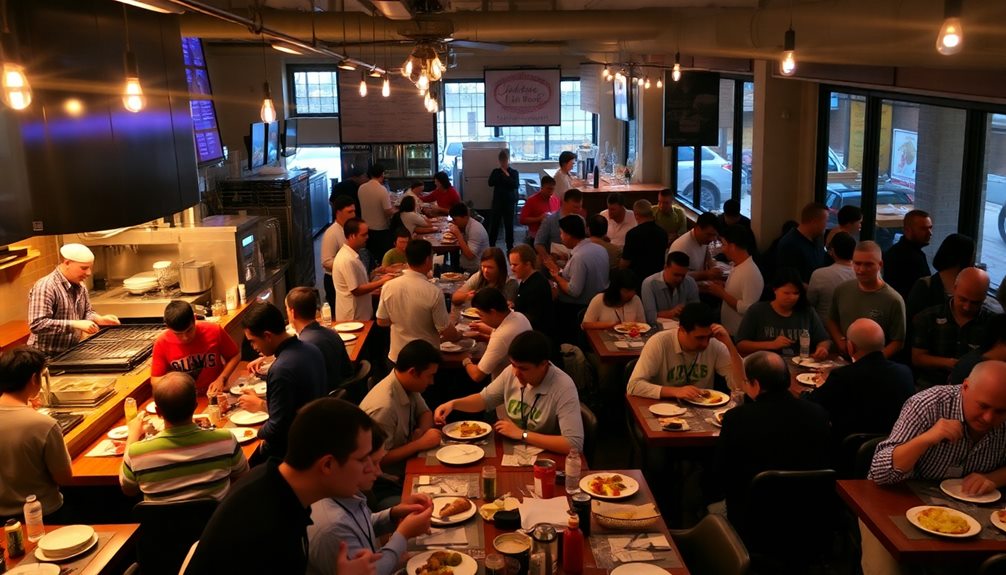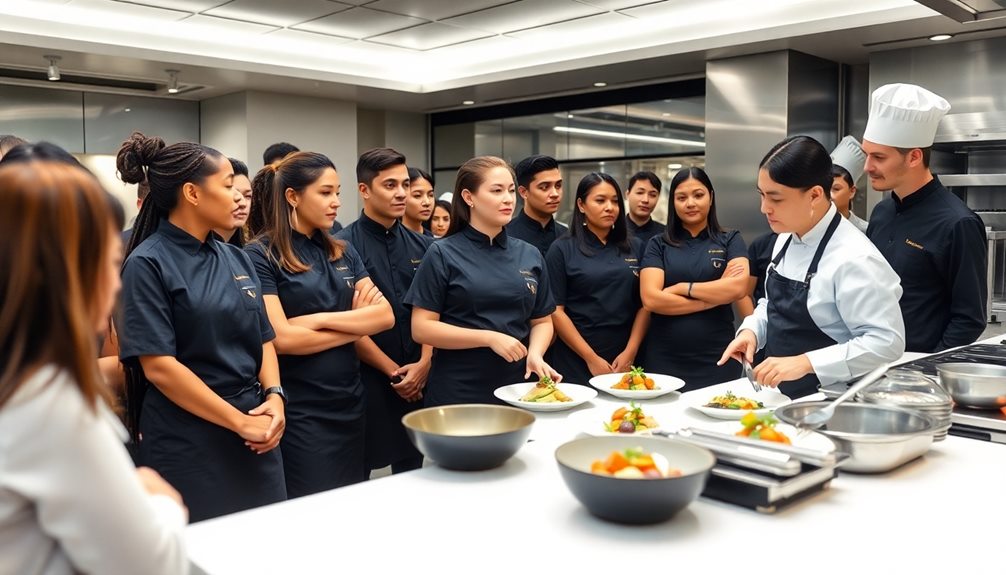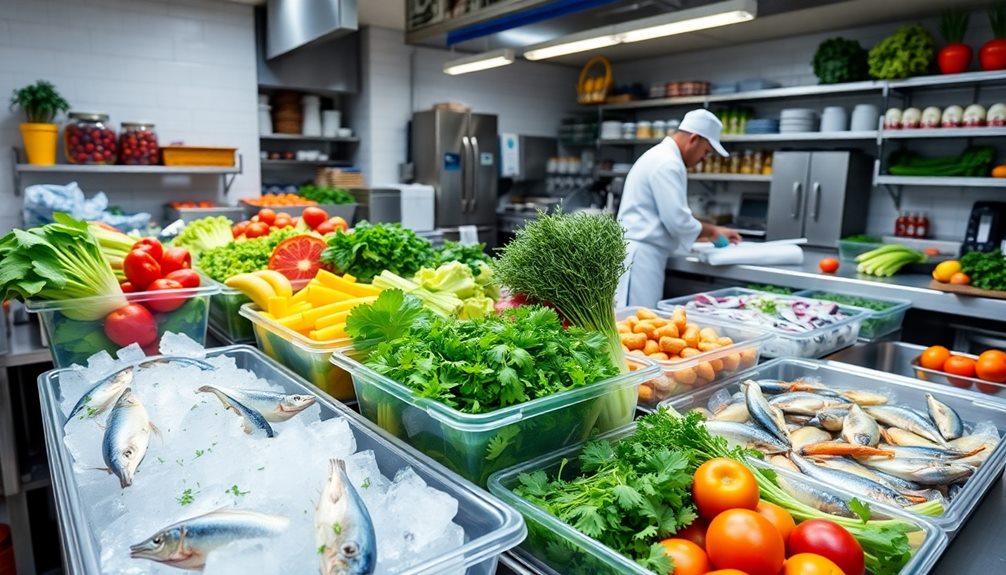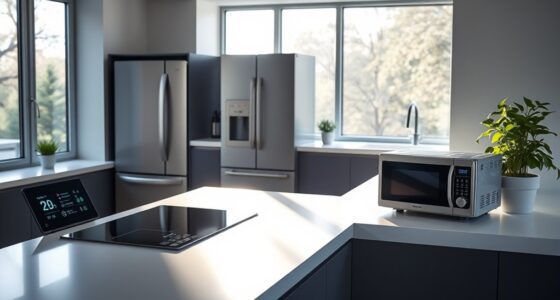Restaurants handle rush hours by implementing strategic staffing and efficient communication. They analyze past data to adjust staff levels, ensuring quick service. Employees often get cross-trained for flexibility, while tools like headsets enhance coordination. Technology plays a key role too, with advanced POS systems and online ordering easing congestion. Optimizing the menu and layout helps streamline operations and customer flow. Additionally, establishing realistic wait times fosters a better dining experience. All these practices contribute to smoother operations during busy periods. If you're curious about specific strategies restaurants use, there's plenty more to explore on this topic.
Key Takeaways
- Restaurants analyze historical data to adjust staffing and prepare for peak customer volume during rush hours.
- Effective communication techniques, such as headsets and digital tools, streamline order processing and enhance teamwork among staff.
- Technology like advanced POS systems and online ordering platforms improves service efficiency and reduces wait times during busy periods.
- Optimizing restaurant layout and menu design helps facilitate quick customer decisions and enhances overall dining experience during peak times.
- Continuous improvement methods, including employee feedback and performance reviews, identify bottlenecks and enhance service quality during rush hours.
Importance of Rush Hour Management
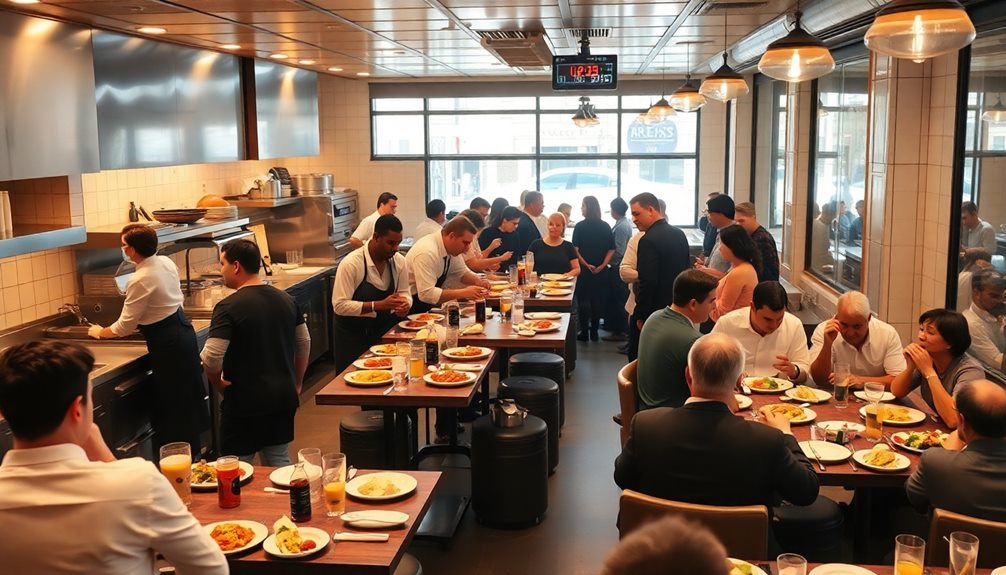
Managing your restaurant during rush hours isn't just about keeping up with the crowd; it's vital for ensuring customer satisfaction. During these peak service times, you need to track metrics like customer volume and wait times to identify operational bottlenecks. This data helps you optimize resource allocation and improve service efficiency, ultimately leading to a smoother customer experience.
Adequate staffing is essential. By ensuring you have enough trained employees on hand, you can greatly reduce wait times and alleviate stress on your team. This not only enhances the overall experience for diners but also boosts your restaurant's reputation, encouraging repeat visits.
Different cuisine types may peak at different times, so understanding these patterns can help you prepare effectively.
Staffing Strategies for Peak Times
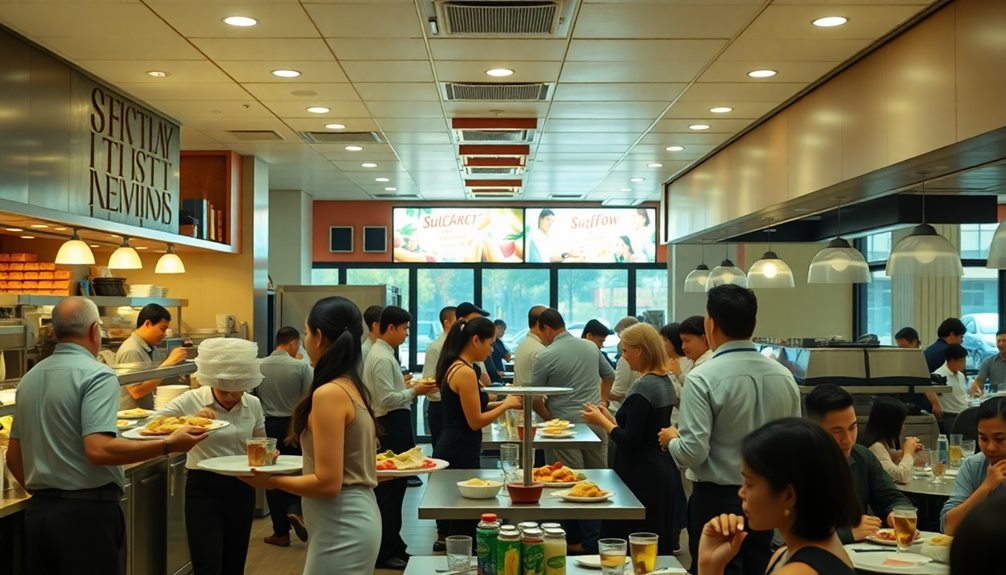
To thrive during peak times, restaurants must adopt strategic staffing practices that anticipate customer demands. By analyzing historical data, you can identify peak hours and schedule additional staff to effectively manage rush hours. This proactive approach guarantees you're prepared for higher volume, leading to improved service speed.
Cross-training employees in multiple roles enhances flexibility, allowing your team to adapt to varying demands during busy periods. This prevents workflow bottlenecks and keeps operations running smoothly.
Additionally, implementing floater roles enables you to address immediate staffing needs during unexpected rushes, guaranteeing that skilled staff are available in key positions.
Regular performance reviews help pinpoint training needs, enabling you to provide ongoing training that boosts staff efficiency during peak times. Adequate staffing not only improves service but also contributes to higher employee morale, which reduces turnover rates.
When your employees feel supported and efficient, it directly enhances the overall customer experience.
Effective Communication Techniques
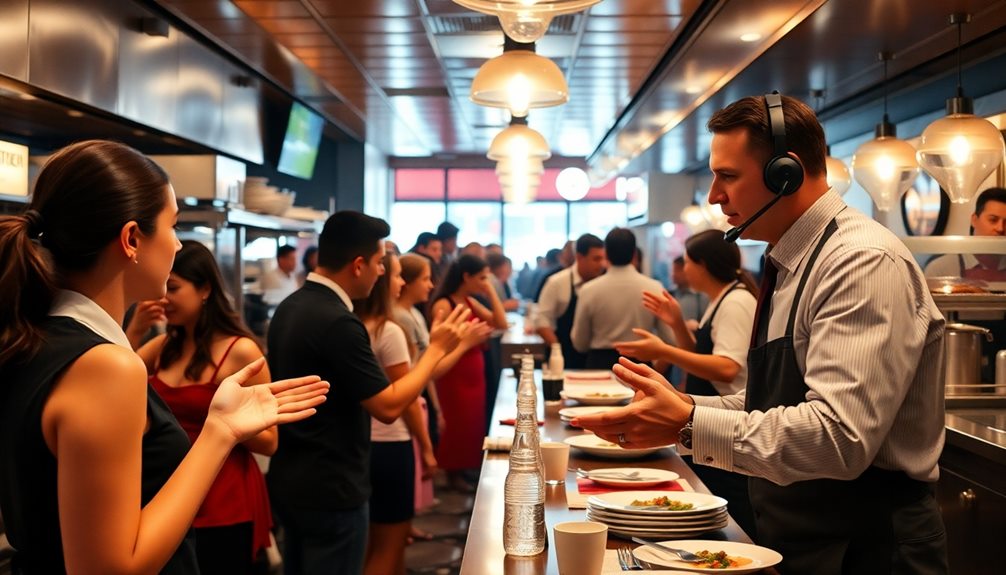
Effective communication techniques are fundamental for restaurant staff during rush hours, as they can greatly enhance service efficiency and customer satisfaction. Using headsets or hand signals allows you and your team to process orders quickly and accurately, reducing errors and wait times.
Regular staff training focused on active listening and clear communication is essential for fulfilling customer orders accurately, especially during busy periods.
Implementing digital communication tools, like messaging apps, lets you update your colleagues on table availability, menu changes, and customer requests in real-time. This smooth flow of information helps maintain effective communication and guarantees everyone is on the same page.
Encouraging teamwork and establishing a positive attitude among staff creates a pleasant atmosphere, which is crucial for improving customer satisfaction during peak hours.
It's also important to communicate realistic wait times to customers. By being transparent about delays, you help manage their expectations and reduce frustration, making their experience more enjoyable.
Technology for Improved Efficiency
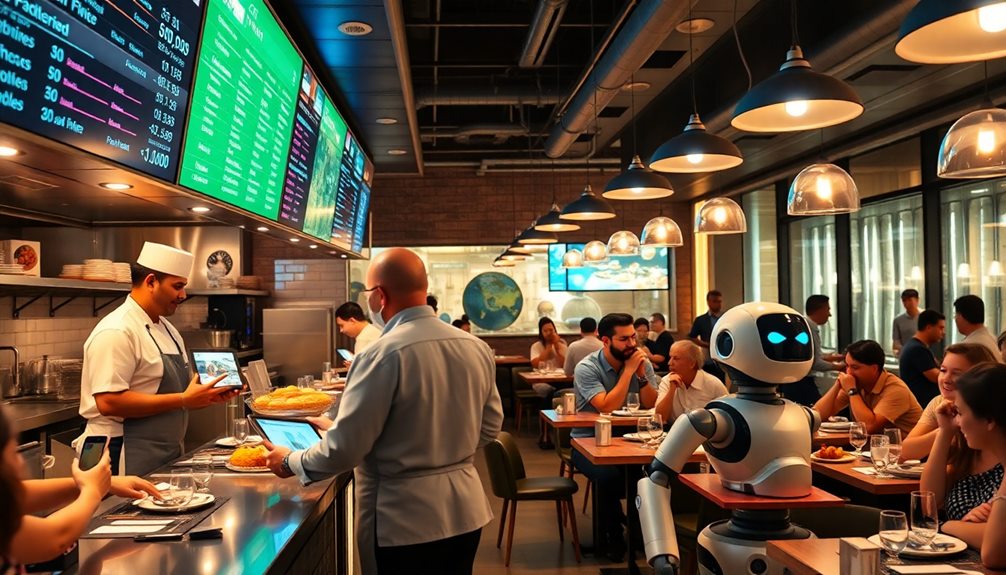
Efficiency in a bustling restaurant hinges on technology that streamlines operations and enhances service. By investing in an advanced restaurant POS system, you can process orders swiftly, reducing wait times and improving order accuracy during peak hours.
Integrating a kitchen display system with your POS technology further optimizes order management, minimizing errors and fostering better communication between your front-of-house and kitchen staff.
Implementing online ordering platforms allows customers to place orders in advance, helping to manage customer flow and alleviate congestion during rush periods. You can also utilize QR code menus, enabling patrons to view and order directly from their tables, which speeds up the process and reduces the need for waitstaff intervention.
Moreover, reservation management tools assist you in balancing customer demand with available seating capacity, ensuring an optimized dining experience during busy hours.
By embracing technology, you're not just enhancing efficiency; you're also boosting customer satisfaction. Utilizing a waitlist system can further streamline operations, allowing you to manage guest flow effectively.
In this fast-paced environment, leveraging these technological solutions becomes essential for maintaining high standards of customer service while maneuvering through rush hours.
Space and Menu Optimization
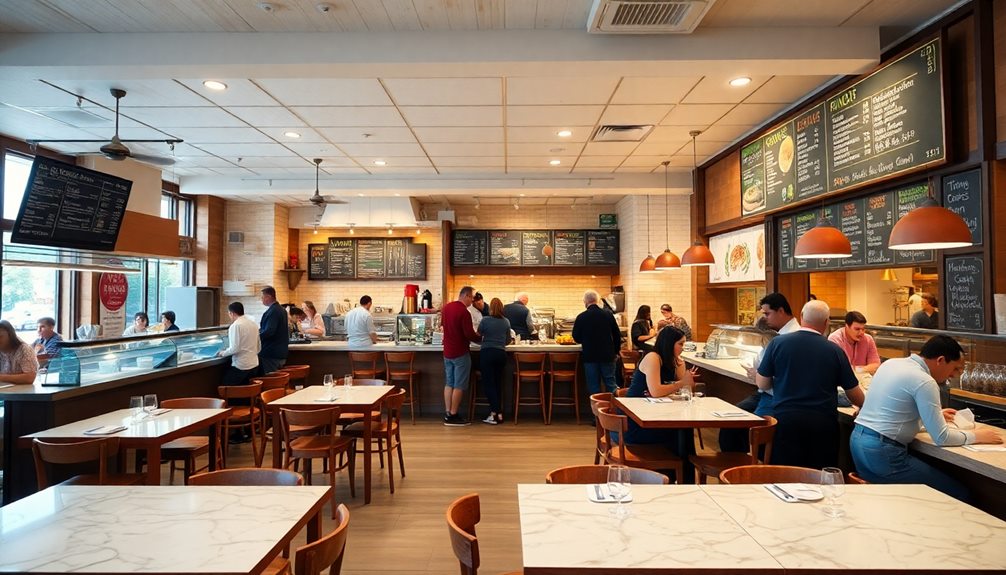
To handle rush hours effectively, you need to optimize your restaurant's layout and menu.
Consider adjusting your seating arrangements to accommodate more guests while keeping a friendly atmosphere.
Additionally, a clear menu and seasonal updates can help speed up decision-making and keep your offerings fresh.
Efficient Restaurant Layout
An efficient restaurant layout not only boosts seating capacity but also enhances the overall dining experience during rush hours. By strategically arranging seating arrangements, you can create an inviting atmosphere that accommodates more guests comfortably. Options like communal seating and outdoor areas can further maximize space during busy periods.
Additionally, evaluating kitchen operations for ideal staff movement is essential. A well-designed kitchen reduces bottlenecks, allowing for faster service and improved operational efficiency. This setup is vital for delivering exceptional service when customer demand peaks.
Using menu intelligence tools can also streamline your offerings. By analyzing sales data, you can identify popular items and adjust your menu accordingly. A clear, concise menu helps guests make quick decisions, enhancing their experience during rush hours.
Moreover, implementing special promotions during peak times can greatly increase revenue. When guests see attractive offers, it can encourage higher spending and customer satisfaction.
To summarize, an efficient restaurant layout, combined with smart menu strategies, not only meets increased customer demand but also guarantees your restaurant thrives during those busy periods. To achieve this, focusing on optimizing operations and delivering exceptional dining experiences is crucial. Incorporating elements like ambiance and stunning vistas can elevate your establishment, taking inspiration from some of the best NYC restaurants with views. By doing so, you can attract more patrons looking for both great food and a memorable atmosphere, ensuring your restaurant stands out from the competition.
Seasonal Menu Adjustments
Seasonal menu adjustments not only keep your offerings fresh but also draw in customers enthusiastic to try dishes made with in-season ingredients. By analyzing sales data, you can pinpoint popular items and use customer feedback to create limited-time offers that cater to increased demand during peak hours. This strategy not only excites your regulars but also attracts new customers keen for unique flavors.
Rotating your menu seasonally helps streamline kitchen workflow, ensuring that your staff can efficiently prepare dishes without feeling overwhelmed during busy periods.
Focusing on seasonal ingredients means you can manage inventory better, reducing waste and improving profitability.
Incorporating special promotions or bundles based on these seasonal items can drive sales during rush hours, encouraging customers to opt for higher-margin offerings.
A clear menu design that highlights these seasonal features enhances customer decision-making and speeds up order processing, reducing wait times and improving the overall dining experience.
Clear Menu Design
Enhancing your menu design can greatly impact customer experience during rush hours. A clear menu design helps customers make quick decisions, which can notably reduce wait times and keep things running efficiently.
By incorporating visual elements like images or icons, you can enhance readability, allowing customers to grasp their options quickly, especially in high-pressure dining situations.
Utilizing a streamlined menu featuring popular and quick-to-prepare dishes enables your kitchen to serve more customers effectively during peak times. This not only meets customer expectations but also keeps the flow of service smooth.
Seasonal menu changes can attract new customers while retaining interest from regulars, as fresh options can be highlighted easily.
Implementing clear pricing and concise item descriptions minimizes confusion, allowing your staff to assist customers swiftly. This optimization of the dining experience is vital during busy hours, as it guarantees everyone feels attended to and satisfied with their choices.
Customer Management Practices

Managing customers effectively during rush hours is vital for maintaining a positive dining experience. To achieve this, restaurants must focus on strong customer management practices. One key strategy is utilizing a reservations system, which helps manage customer flow and optimizes seating arrangements during busy times. By setting realistic wait times and maintaining transparency, you'll enhance customer expectations and keep them informed.
Additionally, drawing from insights on supporting a partner ready for parenthood, effective teamwork among staff can greatly improve service efficiency.
Effective communication among staff is essential during peak hours. Using tools like headsets or hand signals guarantees orders are processed efficiently, minimizing errors in food preparation. Additionally, training your staff in active listening and conflict resolution equips them to handle inquiries and complaints adeptly, turning potential negative experiences into positive ones.
Another important aspect is regularly gathering customer feedback. By analyzing this information, you can identify areas for improvement and refine your service practices. This commitment to understanding your customers not only enhances their satisfaction but also fosters a loyal clientele.
Continuous Improvement Methods
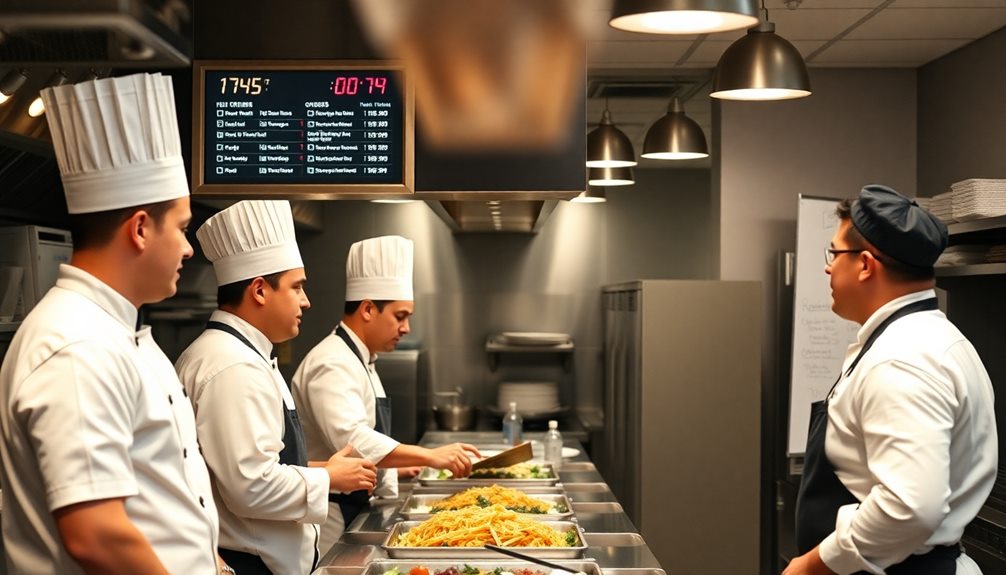
To thrive in the competitive restaurant industry, it's vital to embrace continuous improvement methods that adapt to the ever-changing demands of your customers. One effective strategy is data collection during rush hours. By evaluating management strategies and identifying bottlenecks, you can pinpoint areas for future operational improvements. Implementing data-driven decision-making allows you to analyze customer preferences and adjust your offerings accordingly.
Conducting employee debriefs post-rush is another valuable practice. These sessions allow your team to discuss challenges faced and share insights that enhance service quality. Additionally, monitoring customer feedback through surveys helps you adapt your service to better meet their needs.
Regularly analyzing sales data during peak hours is essential for making informed decisions. This analysis informs necessary staffing adjustments, ensuring you have the right number of employees to handle busy shifts. By focusing on efficient operations, you can streamline workflows and minimize wait times.
Establishing a culture of continuous improvement fosters long-term profitability. By consistently adapting to changing customer demands and operational challenges, you create a dynamic restaurant environment that not only meets but exceeds expectations.
Embrace these methods, and your restaurant will thrive during rush hours and beyond.
Preparing for Anticipated Challenges

Anticipating challenges during rush hours is vital for maintaining smooth operations in your restaurant. To effectively manage these busy times, you need to engage in proactive planning.
Start by analyzing historical data to identify peak hours and adjust your staffing levels accordingly. Confirming you have enough staff to handle the increased customer demand is essential.
Additionally, implementing a strategy similar to those used in puppy training classes can enhance team readiness, as group classes provide socialization opportunities for staff to work together efficiently.
Training your team on your master plan prepares them for unexpected situations, promoting efficient operations during the rush. Regularly updating your inventory before peak hours can also help prevent stockouts, keeping service delays at bay and enhancing customer satisfaction.
Moreover, after each rush hour, take the time to review performance. This practice allows you to identify areas for improvement and refine your strategies for future busy periods.
Frequently Asked Questions
How to Handle Rush in Restaurant?
To handle a rush in your restaurant, analyze peak times, cross-train staff for flexibility, implement efficient order systems, and utilize reservations. Regularly train your team to manage high-pressure situations effectively, ensuring great service every time.
How to Deal With a Rush as a Server?
When you're swamped like a lifeguard in a tidal wave, stay focused! Know the menu, communicate clearly, prioritize tasks, and manage expectations. Your calm efficiency will turn chaos into a smooth, satisfying experience for everyone.
What Does Rush Hour Mean in a Restaurant?
Rush hour in a restaurant means peak customer times, usually during lunch and dinner. You'll notice higher volumes, which can affect service speed and quality. Understanding this helps you prepare for busy periods effectively.
How Do You Manage a Busy Restaurant?
To manage a busy restaurant, you'll need to schedule enough staff, utilize efficient technology, and cross-train employees. Regularly analyze performance metrics and streamline your menu to enhance service and improve customer satisfaction during peak times.
Conclusion
In summary, effectively managing rush hours is essential for a restaurant's success. Did you know that restaurants can lose up to 75% of potential repeat customers due to poor service during peak times? By optimizing staffing, embracing technology, and refining communication, you can turn those hectic hours into opportunities. Remember, every busy moment is a chance to impress your customers and keep them coming back. Stay prepared, adapt, and watch your business thrive during those rush hours!
